How to batch rename files in Windows 11
Rename files using Windows 11 File Explorer
Although it may not be obvious, File Explorer in Windows 11 does have the ability to rename a batch of files at once. This doesn't give you a lot of options, but if you just want to rename a bunch of files to a standardized format, this might be what you need. Here's how you do it:
- Open File Explorer and navigate to the folder containing the file you want to rename.
- Select all files to be renamed. If you don't want to select each file, you can hold down the Shift key and select the files individually.
- Click the Rename button on the toolbar or right-click on one of the selected files and select the Rename option in the context menu.

- #Only one of the files will display an editable text box, but the name will be applied to every file you select. Write the file name you want and press the Enter key on your keyboard.

- Your files will now all have the name of your choice, followed by a number.

It's a fairly simple process and as we've already mentioned you don't have a lot of options, but it's probably going to work well for a lot of people.
Rename files using PowerToys
If you want more options on how to rename your files, a good option is to use Microsoft's own PowerToys software. Modern versions of PowerToys (the original PowerToys was designed for Windows 95 and XP) come with a tool called PowerRename that you can use to batch rename files on Windows 11 using a series of conditions to get the exact format you want. It's a bit complicated, but it's probably worth it to get the results you want. First, you need to install PowerToys and make sure PowerRename is running:
- Download the latest PowerToys installer from GitHub (you will need to scroll down to the bottom of the page to find the installation file) and install the program. Once the installation is complete, the Welcome to PowerToys window should open automatically.
- Select PowerRename from the side menu and click Open Settings. If you don't see the welcome window, open PowerToys from the Start menu and select PowerRename from the left sidebar.
- Make sure the PowerRename feature is set to On (it should be the default setting).

With PowerRename enabled, you can now go to your files and start renaming them. PowerRename is much more powerful than the simple renaming tool in Windows 11. You can match any word or character in the original filename and replace it with something else, so you can change just part of the name to make the file easier to identify. You can also use regular expressions (RegEx) to create certain conditions to Match filenames and change them to something else. How to do it:
- Use File Explorer to navigate to the folder where the file is located.
- Select all the files you want to rename, then right-click on them and select See more options in the context menu. Then, select PowerRename in the second context menu.
-

Note: Here, you can use various conditions to rename the files you want. You can match any text in the original name, use regular expressions to match entire words and numbers, and more. You can click the information icon next to the text box to see the supported expression types. In the bottom box you can choose what the matching text will be replaced with. These were photos taken for our Lenovo Yoga 6 review, so let's name the files after the laptop. We'll also add an extra space at the end to separate the timestamp from the word itself. -
 As we mentioned, there are a lot of options here, including adding the date and time to the filename if you haven't already. You can also enumerate items if you name them the same thing. You can see what the final filename will look like before applying the changes, so make sure everything is how you want it.
As we mentioned, there are a lot of options here, including adding the date and time to the filename if you haven't already. You can also enumerate items if you name them the same thing. You can see what the final filename will look like before applying the changes, so make sure everything is how you want it.
Click - Apply and the file name will be changed according to your conditions. You can see the new name in File Explorer.

The above is the detailed content of How to batch rename files in Windows 11. For more information, please follow other related articles on the PHP Chinese website!

Hot AI Tools

Undresser.AI Undress
AI-powered app for creating realistic nude photos

AI Clothes Remover
Online AI tool for removing clothes from photos.

Undress AI Tool
Undress images for free

Clothoff.io
AI clothes remover

Video Face Swap
Swap faces in any video effortlessly with our completely free AI face swap tool!

Hot Article

Hot Tools

Notepad++7.3.1
Easy-to-use and free code editor

SublimeText3 Chinese version
Chinese version, very easy to use

Zend Studio 13.0.1
Powerful PHP integrated development environment

Dreamweaver CS6
Visual web development tools

SublimeText3 Mac version
God-level code editing software (SublimeText3)

Hot Topics
 1387
1387
 52
52
 The driver cannot load ene.sys on this device in Windows 11
May 05, 2023 am 09:13 AM
The driver cannot load ene.sys on this device in Windows 11
May 05, 2023 am 09:13 AM
Many Windows 11 users have encountered the error message “The driver could not be loaded on this device (ene.sys)” which prevents the driver from loading on the system and is marked as vulnerable. However, this issue is mainly reported by users who have upgraded their PC to Windows 11. This error is closely related to drivers and files that get corrupted due to system operating system update issues. If you are encountering this “ene.sys” error every time you turn on your Windows 11 computer after an update, continue reading this article. Here you will find some troubleshooting methods that you can use if you see this error on your PC. Fix 1 – Install Optional Update Step 1. Use Windows+R group
 4 Ways to Quickly Rename a Printer on Windows 11
Sep 11, 2023 pm 03:26 PM
4 Ways to Quickly Rename a Printer on Windows 11
Sep 11, 2023 pm 03:26 PM
If you have a lot of printers in your office, the printer list can be long and make getting work done tedious. What's more, multiple printers usually mean similar names, which can be a bit confusing. The last thing you want is to scroll through an endless list and still end up sending your print job to the wrong printer. Fortunately, you can solve all of these problems with a simple renaming trick, which we'll show you below. How do I rename my printer in Windows 11? 1. Using the Settings app tap the key and click Settings. Windows click Bluetooth and Devices and select Printers and Scanners. Select the printer you want to rename. Click Printer Properties. Navigate to the General tab, key
![Explorer.exe does not start on system startup [Fix]](https://img.php.cn/upload/article/000/887/227/168575230155539.png?x-oss-process=image/resize,m_fill,h_207,w_330) Explorer.exe does not start on system startup [Fix]
Jun 03, 2023 am 08:31 AM
Explorer.exe does not start on system startup [Fix]
Jun 03, 2023 am 08:31 AM
Nowadays, many Windows users start encountering severe Windows system problems. The problem is that Explorer.exe cannot start after the system is loaded, and users cannot open files or folders. Although, Windows users can open Windows Explorer manually using Command Prompt in some cases and this must be done every time the system restarts or after system startup. This can be problematic and is due to the following factors mentioned below. Corrupted system files. Enable fast startup settings. Outdated or problematic display drivers. Changes were made to some services in the system. Modified registry file. Keeping all the above factors in mind, we have come up with some that will surely help the users
 CS:GO crashes, freezes and black screen issues in Windows 10/11
Apr 30, 2023 pm 06:40 PM
CS:GO crashes, freezes and black screen issues in Windows 10/11
Apr 30, 2023 pm 06:40 PM
Just like any other game on your PC, Counter-Strike: Global Offensive can crash, freeze, or get stuck in a black screen on launch. Counter-Strike is one of the low resource fps games on the market and it even runs on Tudou PC. Although CSGO is a CPU-oriented game, the system GPU also plays an important role. The black screen issue is related to GPU issues. Follow these simple solutions to solve the problem. Fix 1 – Turn off compatibility If you are running the game in compatibility mode on Windows 8 or 7, turn it off. CSGO works with every version of Windows (WindowsXP or higher)
 How to batch rename file suffixes in win10
Jul 06, 2023 pm 07:37 PM
How to batch rename file suffixes in win10
Jul 06, 2023 pm 07:37 PM
How to batch rename file suffixes in win10? Nowadays, many users are using the Win10 system, and when we usually use computers, we often use a lot of shortcut keys, because shortcut keys can make our operations more convenient, so how do we rename files in batches? Below, the editor will introduce to you the operation of batch renaming files in Win10. How to batch rename files in Win10 1. Select all the files you want to rename. 2. Right-click on a selected file and select Rename. 3. After a file is renamed, other files will be marked with serial numbers in turn. The method is very simple, but when modifying, you need to pay attention to the order of the files and the sorting position of the modified sample files. The serial number starts from the modified sample file.
 What is the shortcut key for renaming? What is the shortcut key for renaming?
Feb 22, 2024 pm 02:50 PM
What is the shortcut key for renaming? What is the shortcut key for renaming?
Feb 22, 2024 pm 02:50 PM
The shortcut key for renaming is F2. Analysis 1 The shortcut key for renaming is F2. 2 If you want to rename a file or folder, you can press F2 after selecting the file, modify it directly and press Enter. 3 Sometimes you can also use the mouse to select the file, right-click, select Rename, and press Enter after the modification is completed. 4 Shortcut keys refer to the special combination or sequence of keys on the keyboard to quickly complete a certain command, which can effectively improve work efficiency. Supplement: What are shortcut keys? 1 Shortcut keys, also called hot keys, refer to completing an operation through certain specific keys, key sequences or key combinations. You can use shortcut keys to do some work instead of the mouse. You can use keyboard shortcuts to open, close, and navigate the start menu, desktop, menus, and dialog boxes.
 How to change file type on Windows 11/10
Oct 27, 2023 pm 02:13 PM
How to change file type on Windows 11/10
Oct 27, 2023 pm 02:13 PM
Changing the file type (extension) is a simple task. However, sometimes simpler things can get tricky, and changing file extensions is one of them. Extreme care should be taken when changing file types, as a simple mistake can brick the file and render it inoperable. So, we discussed various ways to change file types on Windows 11, 10. How to Change File Type on Windows 11, 10 There are two ways to do this. You can use the direct GUI method (in File Explorer) or you can change the file type from the terminal. Way 1 – Using File Explorer Way 2 – Using CMD Terminal Way 1 – Changing the file type directly You can directly change the file type from up and down in File Explorer
 PHP function introduction—rename(): Rename a file or directory
Jul 25, 2023 pm 12:10 PM
PHP function introduction—rename(): Rename a file or directory
Jul 25, 2023 pm 12:10 PM
PHP function introduction—rename(): Renaming files or directories Introduction: In PHP, the rename() function is used to rename files or directories. It provides an easy way to change the name of a file or directory. Whether it is a single file or an entire directory, you can use this function to perform a rename operation. The renaming process can be easily accomplished by specifying the name of the source file or directory and the target name. Syntax: boolrename(string$source,str



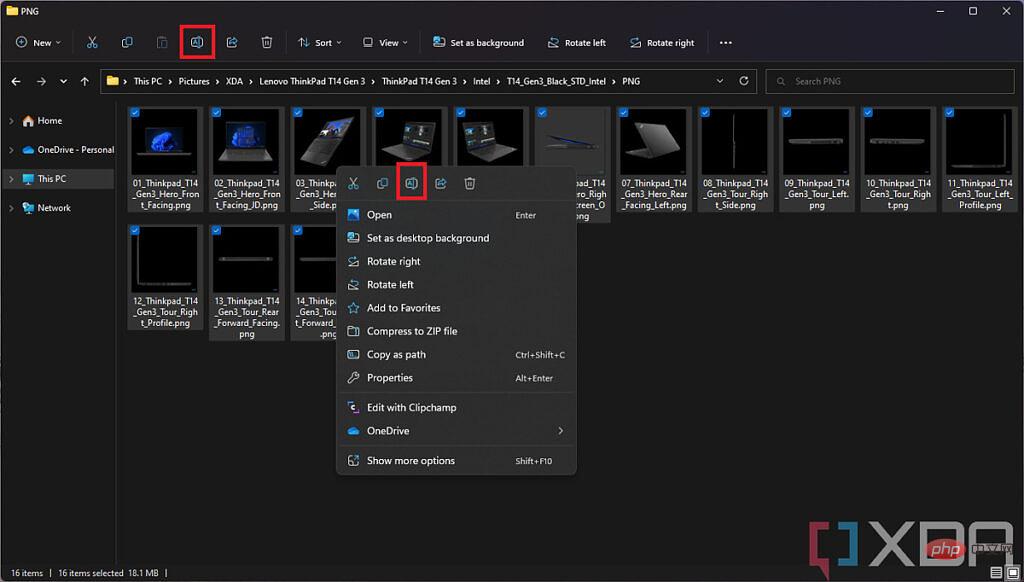

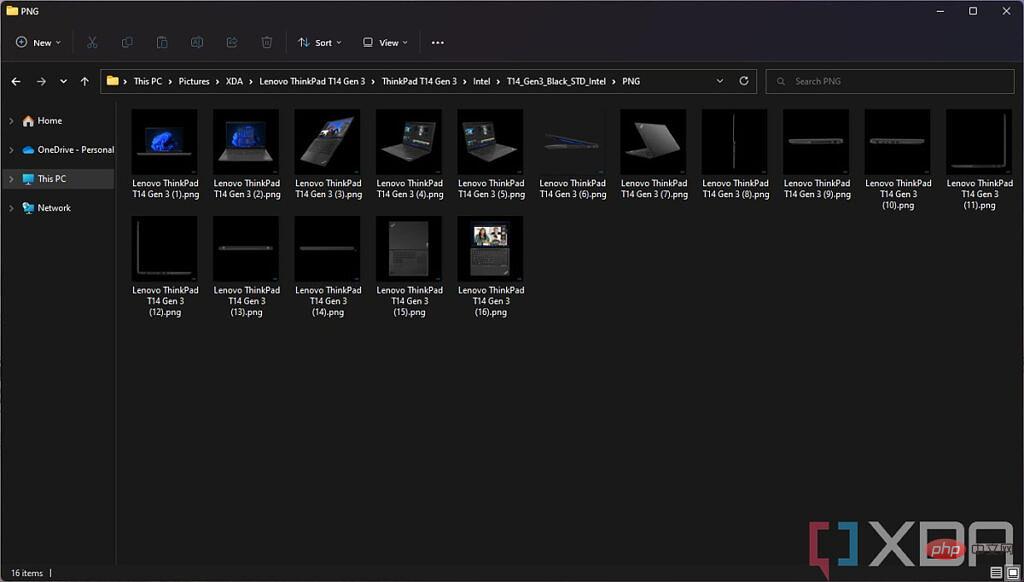

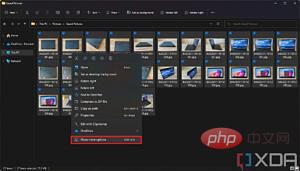

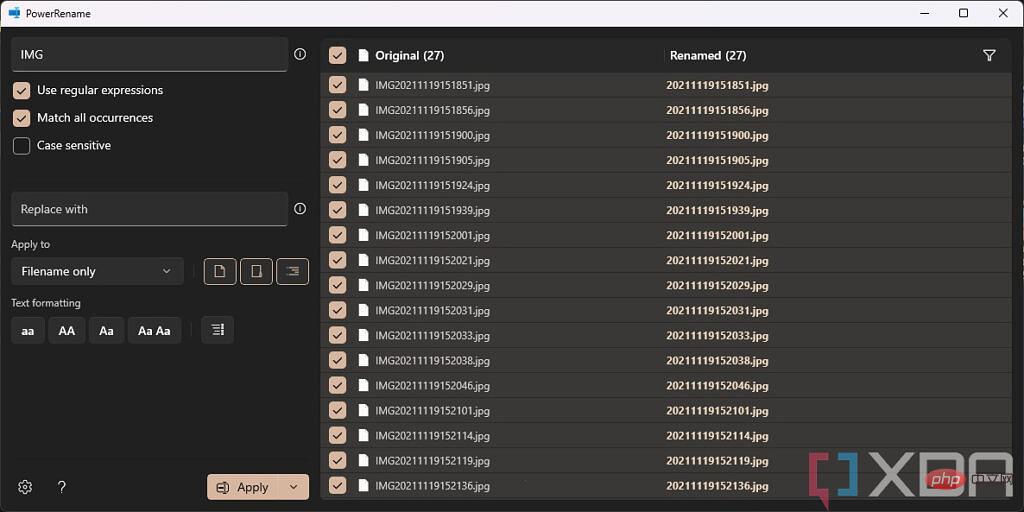
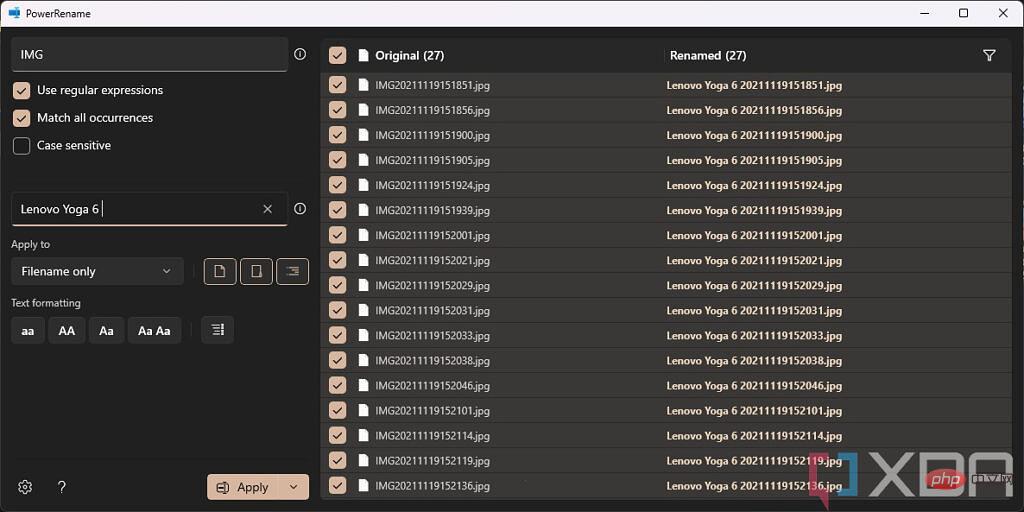 As we mentioned, there are a lot of options here, including adding the date and time to the filename if you haven't already. You can also enumerate items if you name them the same thing. You can see what the final filename will look like before applying the changes, so make sure everything is how you want it.
As we mentioned, there are a lot of options here, including adding the date and time to the filename if you haven't already. You can also enumerate items if you name them the same thing. You can see what the final filename will look like before applying the changes, so make sure everything is how you want it. 
